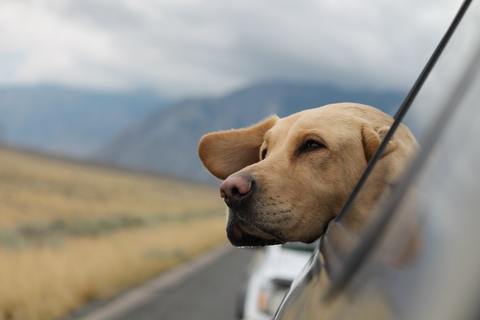By: Sara Ondrako, Certified Canine Behavior Consultant
Teaching your dog new tricks has many benefits beyond impressing your family and friends. Teaching them new things helps keep their brains sharp and mentally stimulated. Spending one-on-one time with your pup helps strengthen your bond with each other. And, of course, it’s an easy way to show your dog how much you love them by giving them more quality time with their favorite person (you!).
Many pet parents love teaching their dogs cute and easy tricks like how to lie down, roll over, high-five, shake hands (or paws), and play dead. To give you even more skills to add to your pup’s repertoire, here are five other fun tricks to try. Beginners have no fear; these are some of the easiest tricks you and your pup can learn. You don’t have to be a dog trainer to follow these step-by-step instructions using simple positive reinforcement training methods your canine companion can easily follow.
Grab your treat pouch, fill it with kibble and some high-value goodies like freeze-dried turkey bites or liver, and let’s get started!
Trick #1: Sit Pretty
Sit Pretty is always the best dog trick for earning extra “aww!” points that lead to even more treats! Your pup should already be able to reliably sit on command to accomplish this trick.

Here’s how to get your dog sitting pretty.
- Begin with your dog in the sitting position.
- Raise your arm parallel to the floor in front of your dog just below chest height. With your other hand, place a treat up and over their nose – encourage your dog to get the treat.
- As soon as your dog’s paw lifts off the ground to start to try and reach the treat, mark it “yes!” and give them the treat.
- Repeat step 3 a few times, then wait for two paws to come slightly off the ground, mark it “yes!” and give them a treat.
- Repeat step 4 a few times. Then, as both paws start coming up more reliably, use your forearm to help your dog balance as needed while they are learning to sit back on their bottom with two paws up. The arm is temporary and can help if a dog doesn’t feel stable with both paws off the ground. Once your dog is more stable on two paws, hold the treat up, remove your arm as they bring both paws off the ground, and quickly mark “yes!” followed by giving the treat.
- Next, roll in the verbal cue (command word) – right as their paws are coming up in position towards the treat above them, say “sit pretty” and give the treat. Repeat several times.
- Then start using the verbal cue “sit pretty” as you are positioning the treat above them. Repeat several times.
- Next, hold the treat in front of you but not above their head anymore and say, “sit pretty,” then wait. As your dog starts moving into position (it doesn’t have to be perfect to get the treat), mark it “yes!” and give them the treat. Repeat a few times. You may have to break this down into a few steps starting with slightly below the first position, then slightly lower, and then lower still if your dog struggles with this step.
- Finally, hide the treat and ask your dog to “sit pretty” and wait. As your dog starts to move into position, mark it “yes!” and give the treat. After repeating a few times with success, ask, “sit pretty,” After your dog lands in that position, wait for a second, mark it “yes!” wait one more second and then deliver the treat to your dog.
For a more dramatic “sit pretty,” see if you can encourage your dog to learn how to go straight from the down position rather than a seated position, up into sit pretty.
Trick #2: Twirl (aka Spin)
Spin is a great trick for pet parents who love making TikTok dance videos and want to include your pup! Your dog should be able to reliably follow a lure to accomplish this trick.

Here’s how to teach your dog to spin:
- Start with your dog in a standing position and use a treat in front of your dog’s nose to lure them in front of you clockwise slowly. When you complete one full around-the-clock turn, mark it “yes!” and give the treat to your dog. (You can also start going counterclockwise, but stick with one direction before teaching them the opposite direction.) Repeat several times until you have a nice, even round circle with them moving in one direction.
- Next, hide the treat in the palm of your hand with a closed fist and point one finger from the same hand to use your finger as the bridged lure in front of your dog’s nose to make the same circular clockwise motion. As soon as the dog completes the circle by following your finger, mark it “yes!” then open your hand and present the treat to your dog. Repeat several times.
- Next, place the treat in your palm and point your finger again, this time not in front of your dog’s nose but slightly higher than their head and encourage them to follow that circular motion again. Treat and repeat.
- Add in the cue word “spin right” – use the same motion as in step three, and as soon as your dog moves to spin around, use the words “spin right.” Treat and repeat. You want to mark the action of spinning as it is happening at first.
- After your dog has had a few sessions practicing with the word and the motion with your hand further away from the dog, start a new session at step 4 and practice step 4 three times. Then, eliminate the hand motion altogether, and give the cue words “spin right.” Treat and repeat several times.
- Once your dog has this down (will respond 99% of the time and can spin under mild distraction), you can teach the opposite spin (counterclockwise / spin left) so your pup can turn on cue both ways.
Advance this by asking your dog to spin in more challenging places, such as in their kennel, when you open the door before they are released. When your pup learns to reliably follow your cues no matter the location or distraction, you know you’re in sync with your training partner.





